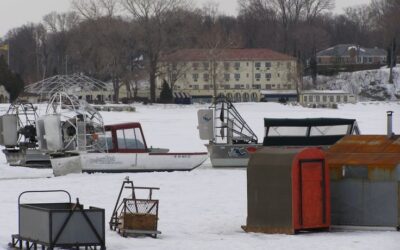Winter Fun On The Ice Put-in-Bay
Ice cars, four-wheelers, and snowmobiles make ice travel today easy and fast on the ice. Although it wasn’t so many years ago that things were a lot different and a lot more complicated. In the old days, you traveled on the ice by horseback, were towed in a sled, in an ironclad boat, or walked across the hard lake. Most times travel this way was slow and uneventful, but there were days when it was dangerous after all ice conditions are dictated by the weather and can change as quickly under the surface as above.
The Islanders took these moments with a grain of salt and didn’t think much about getting wet, in fact, there was a common saying about falling through the ice “went right through till his hat floated off”. They would just pull themselves out and hurry along to the closest place to warm up.

It is fun and exciting to learn the tales and stories that make up the winter history of the islands. For example, Simon Fox from North Bass was returning home in his sleigh on the ice when the area he was on began to break off, which would send him drifting out in the open lake.
He was able to run and jump over the crack, making it to more solid ice, but his horse and sleigh were floating slowly away upon the berg. Simon walked the rest of the way home, gathered some help, and returned to try and recover the horse.
They were successful in their endeavor, and it wasn’t long before the horse was back in his stall and Simon was safely home warming his feet by the fire—another time and old islander by the name of Capt. Tullian was crossing the ice in the channel between North Bass and Middle Bass towards the end of the winter season. Some said he should have known better this late.
He not once but twice broke through with the same horse within the same week. The poor horse plunged into icy waters to the point it had to swim to stay alive. However, he was pulled to safety by having a line wrapped around its neck, choking the horse; this would make the body come up on the surface more, making it easier to pull the animal onto the stronger ice.
This was the practice among all the islands, often, the approach was successful, but there were times it wasn’t, and whole teams, along with all the cargo, would sometimes be lost. Today we fly or take an airboat when we need to get between the islands and the mainland in the winter months, an excellent safe, quick, and warm way to go. But before the 1930s, it was an ironclad boat, usually about 11-15 feet long; the outside of the hull was covered in iron to protect it from being split open by chunks of ice.
Depending on the conditions, it could be sailed, rowed, and towed. There were several benches to sit upon but no protection from the elements; everyone and everything was exposed. It was not easy and very hard work for the men whose job it was.
The trip was made daily, and the mail would be exchanged, and any freight or passengers were loaded on board. Sometimes the run could be done in a few hours; other times, it could take most of the day. Weight was a significant concern; nasty weather, it could really hamper travel for the carriers, especially when the lake was too frozen for boats but not frozen enough to firmly hold much weight, with the ironclad breaking through with every step.
It was not often that someone perished along the route, but sadly it did at times happen. In the early 1920s, the Pelee Island carriers crossed the 8 miles to the mainland upon thin ice; when they arrived, they found a huge gentleman insisting on paying for passage over to the island. He said he had important business to attend to and could not wait. The carriers, a father and son, tried to talk the man out of going, knowing that a person of this stature would be nearly impossible to push in the boat should he not be able to assist in moving the ironclad the distance back to Pelee.
The gentleman had no idea exactly what he was in for as the group shoved off. They were out on the ice aways when they encountered thin ice, it began to crack all around them, and in an instant, the passenger disappeared below the ice. They pulled him out and got him into the boat, but with his weight, the boat was almost too heavy to move as it kept breaking through.
After a short distance of hard labor, the son checked on the chilled man in the boat, called his father, and discovered that the man was dead; whether he died from exposure or fright, it is not known and could have easily been either. The poor carriers had to struggle the entire trip back to Pelee, and then the next day, they loaded the body back into the boat trip back to the mainland. The journey was just as laborious as the previous day, but the men felt obligated to return the man to his family, who wouldn’t learn of his death until they reached Pt. Pelee.
Wine, too was transported in the winter months on the ice once the lake froze hard enough to travel across. The large wine casks, like those you see at Heineman’s Winery on Put-In-Bay, would be loaded onto sleighs. Often a number of men from the surrounding islands would gather and go in a procession traveling in a single file line to their mainland destination.
It usually was Port Clinton and Sandusky that they headed to. Once there, the men might run errands and load up supplies and daily necessities before returning home across the ice. Even though we now have planes in the winter, there are times when something is needed but too large to be transported through the air. In the middle of a late 1970s harsh winter with frigid temperatures, the boiler in the little one-room school on North Bass broke.
Nothing could be done to make it work, so classes were moved to the Lodge, the boiler was ordered, but the Islanders had to figure out how to transport it. Dale Burris had a dog sled that he towed behind his snowmobile for hauling things; he volunteered to go to the mainland to pick it up. He and some other guys set off to Port Clinton, where the boiler would be waiting at the beach for them; Burger King is located there now.
They made good time and loaded the boiler on the sled, which must have looked odd to the traffic driving by as they prepared for the return to North Bass. Not long before the school was again warm, returning things to normal, however, Dale couldn’t say the same; the boiler was pretty heavy to be pulled back to North Bass on the ice, he recalled, and his dog sled “wasn’t quite right after that, and come to think of it, neither was the snowmobile”.
More than a century of travel on the ice has made for many exciting experiences, and it is fun to take a peek into our past by recalling these stories. It makes you wonder what we will be talking about 20 years from now. After all what
happens today could become tomorrow’s legend.





0 Comments